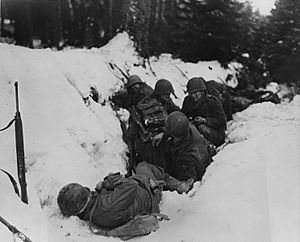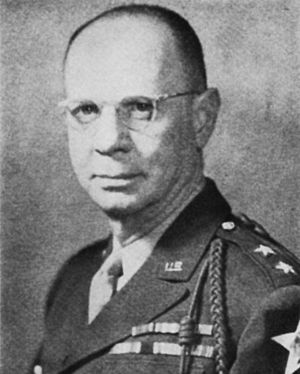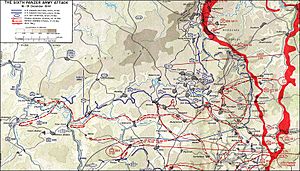Battle of Heartbreak Crossroads facts for kids
Quick facts for kids Battle of Heartbreak Crossroads |
|||||||
|---|---|---|---|---|---|---|---|
| Part of World War II, Battle of the Bulge | |||||||
 Soldiers from the 2nd Infantry Division hide from German artillery fire in the Krinkelter woods on December 14. |
|||||||
|
|||||||
| Belligerents | |||||||
| Commanders and leaders | |||||||
| Units involved | |||||||
294th Volksgenadier Division 18th Volksgrenadier Division |
|||||||
The Battle of Heartbreak Crossroads was an important fight during World War II. It started just one day before the famous Battle of the Bulge. This battle took place at a key three-way road junction called Wahlerscheid. This spot was near a forester's cabin and an old border post, right on the Siegfried Line, which was a strong German defense line.
The crossroads was about 5.6 miles (9 km) north of Krinkelt-Rocherath in Belgium. In December 1944, the U.S. 2nd Infantry Division, a group of experienced soldiers, moved to this area. Their main goal was to capture the crossroads. This would give them a good starting point to attack the Roer River dams. These dams were very important because the Germans could use them to flood the area, stopping Allied attacks.
The first two days of the battle were very tough for the Americans. They couldn't move forward and lost many soldiers. But on the third day, a small group of soldiers managed to sneak behind the German lines. By December 15, the U.S. troops finally captured the crossroads.
However, on December 16, the Germans launched a huge surprise attack, known as the Battle of the Bulge. This attack threatened to cut off the American soldiers at the crossroads. So, they had to pull back to the nearby villages of Krinkelt-Rocherath. These villages were on a main road that the Germans wanted to capture. This led to another big fight called the Battle of Elsenborn Ridge. This was the only part of the Battle of the Bulge where the Allies did not lose ground to the Germans.
Contents
Why the Battle Happened
The Allies (American and other forces) were worried about the Roer River dams. They feared that if their troops crossed the river, the Germans might blow up the dams. This would cause huge floods, trapping or destroying the Allied forces. To prevent this, the Allies needed to capture two main dams.
On December 7, 1944, the 9th Infantry Regiment of the U.S. 2nd Infantry Division received orders. They were to move through the area held by the 99th Infantry Division. Their mission was to capture the Wahlerscheid crossroads, then attack north to take a place called Rohern inside the Siegfried Line. After that, they would capture a hill and then move east to seize a dam. Another group, the 38th Infantry, was tasked with a main attack through the Monschau Forest towards Drieborn.
The area near Wahlerscheid was supposed to be protected by the 99th Division. However, this division was spread out very thin, meaning they had too much ground to cover with too few soldiers. Some areas had no strong defenses and were only checked by occasional patrols. This left a dangerous gap on the northeastern side of the road, open to German attacks. Because of this, General Leonard T. Gerow ordered another group, the 395th Regimental Combat Team, to attack German positions southeast of Wahlerscheid on December 13.
It was hard to know how strong the German forces were because of the thick woods between Krinkelt-Rocherath and Wahlerscheid. The U.S. infantry had strong support. They had tank destroyers, powerful howitzer cannons, rockets, self-propelled guns, chemical mortars, and medium tanks. They also had extra artillery support with large 155mm cannons. A special armored unit, Combat Command B of the 9th Armored Division, was ready to help if the Americans broke through German lines.
On December 13, the American soldiers began their attack. They moved through thick woods and brush on both sides of the road, trying to avoid hidden mines. The soldiers faced many challenges: deep snow, dense forests that dropped wet snow on them, and ravines filled with melting snow that soaked their boots. To make sure they didn't run out of supplies, soldiers carried up to 120 pounds (54 kg) of gear. This included enough food, ammunition, and anti-tank mines to last at least 24 hours.
Where the Attack Happened
Two roads north of Höfen were very important for moving troops and supplies through the area. One was a main paved road that went through the Monschau Forest. The other was a smaller, two-lane road that ran behind the American lines. This secondary road left the main Höfen road at the Wahlerscheid crossroads.
The Wahlerscheid crossroads was heavily defended by the Germans. It had about 25 strong concrete bunkers, called pillboxes. The Germans had cut down all the trees around the crossroads. This gave their soldiers a clear view and allowed them to shoot at anything moving. They also filled the area with anti-personnel mines and thick barbed wire, sometimes six to ten layers deep. The road continued south through the Monschau Forest and the villages of Rocherath and Krinkelt, eventually meeting a main east-west road at Büllingen.
Around December 12, the 2nd Infantry Division moved behind the 99th ID on Elsenborn Ridge. They then passed through the 99th's lines, heading for the Wahlerscheid crossroads. General Walter M. Robertson, the commander of the 2nd Division, gave orders. The 9th Infantry Regiment was to attack along the only road, capture the crossroads, and then turn northwest to clear German forces along the Höfen-Alzen ridge towards Monschau. The 38th Infantry Regiment was ordered to attack northeast from the crossroads along the Dreiborn Ridge, moving towards the Roer River dams. The 23rd Infantry was kept in reserve, ready to help if needed.
Allies Attack
The German forces in the Monschau Forest, about 1.5 miles (2.4 km) southeast of Wahlerscheid, included the 277th Volksgrenadier Division and the 294th Volksgrenadier Division. The U.S. 2nd Infantry Division wanted to surprise the Germans. So, they advanced without first firing artillery. Their movement through the forest went well at first, with little resistance.
But on December 14, when they reached the edge of the cleared forest around the pillboxes, they faced strong defenses. There were four pillboxes, six concrete bunkers, a forester's lodge, and a customs house. These buildings were grouped closely around the road junction. They were set up so that their machine guns and rifles could provide "interlocking fire," meaning they could cover each other and create a deadly zone.
Germans Stop U.S. Advance
The U.S. soldiers were met with intense gunfire from hundreds of German weapons. Soon after the fighting began, a small group of soldiers from Company E crawled forward into the clearing. They managed to reach a small rise in the ground, about 80 yards (73 meters) from the edge of the forest, just before the barbed wire. From this higher spot, they could see the German pillboxes much better.
Captain Homer G. Ross, the commander of Company E, bravely crawled out with two radio operators to join his soldiers. From the middle of the clearing, he used his radio to guide American artillery fire. He successfully called for direct hits on the German pillboxes. However, the soldiers still couldn't get through the thick barbed wire. After the artillery stopped, they had to pull back. The fighting continued for two more days with very little progress. On the first day, the battle for the crossing earned its sad nickname: the Battle of Heartbreak Crossroads.
The Americans pulled their troops back and called in more artillery, including huge 155mm Long Tom cannons. These powerful guns repeatedly fired at the German pillboxes. The Americans also tried to clear the many layers of barbed wire using special explosives called bangalore torpedoes. But wet fuses slowed their progress.
Americans Break Through German Lines
On the south side of the road, two U.S. squads crawled on their stomachs and found a way through the German defenses. They cut the barbed wire and made a path between the German positions. They managed to get into a trench line behind the pillboxes and held off German patrols for five hours. But when night fell, they returned to the American lines.
On December 15, an American patrol went back through the gap in the barbed wire. They captured a part of the German trench line. They quickly told their commanders, and Lieutenant Colonel Walter M. Higgins, Jr., led two companies of soldiers into the trenches behind the pillboxes. By the early morning of December 16, they had taken control of several pillboxes. However, they didn't have enough TNT explosives to destroy them. On December 16, the 9th Infantry Regiment pushed their attack forward another 1,500 yards (1,370 meters) against strong German resistance. They finally captured the crossroads and the roads around it.
The Ardennes Offensive
The U.S. First Army thought the Germans might launch a small attack to disrupt the American advance. So, when the Germans started a 90-minute artillery barrage on December 16, 1944, at 5:30 AM, the Americans only knew what was happening in their immediate area. Even throughout December 16, General Hodges and General Omar Bradley believed the German attack was just a small spoiling offensive, not a major one. General Gerow asked Hodges for permission to stop the attack on Hurtgen and send more troops to help the 2nd and 99th Infantry Divisions. But Hodges said no. The 2nd Infantry Division continued to attack eastward throughout December 16. However, late that evening, they were told to hold their positions.
Americans Pull Back
When General Bradley finally learned that the Germans had attacked the American lines in five different places across an 80-mile (130 km) front in the Ardennes, he knew the Allies were in for a serious fight. On the morning of December 17, parts of the 23rd Infantry Regiment, 2nd Infantry Division, were attacked by a much larger force of German infantry and tanks. They fought off the first six waves of attacks, suffering heavy losses. This led to a desperate last stand. A brave machine gunner named Richard Cowan later received the Medal of Honor for fighting alone and killing an estimated one hundred enemy soldiers before his unit had to retreat. At 12:30 PM on December 17, General Gerow finally got permission from Hodges to break away from the fighting and pull back towards the twin villages.
Retreat to Elsenborn Ridge
During the night of December 16 and the early morning of December 17, General Robertson gathered his forces. Just a day before, they had captured the important crossroads at Wahlerscheid. To the east of Rocherath and Krinkelt, the Germans had pushed deep into the American lines and could burst out of the forest at any moment. The U.S. forces had to hold the twin villages. This would allow the 2nd Infantry Division, with its heavy weapons and vehicles, to reach safe positions around Elsenborn Ridge. The 99th Division had already used all its reserve troops in the battle. So, the 2nd Infantry Division, along with the attached 395th Regiment, was left to defend the dangerous southern part of the corridor.
The 9th Infantry Regiment pulled back to another crossroads in the forest at Baracken, about 5 miles (8 km) south of Wahlerscheid. The other units moved south through the area near the twin villages. General Robertson moved his headquarters from Wirtzfeld to Elsenborn, which was just west of the ridge line. Robertson also told General Leonard T. Gerow, commander of V Corps, that he planned to hold the twin villages. He would hold them until all troops east of the villages had retreated through them to the ridge line. This ridge line would then become the next line of defense. This defensive line was meant to protect the important high ground on Elsenborn Ridge from the German advance.
The Americans later regretted not destroying the German pillboxes at the crossroads. They were forced to recapture the area again in early February 1945.
See also
- Battle of the Bulge
- Siegfried Line




